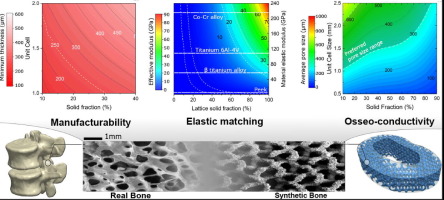Acta Biomaterialia ( IF 9.4 ) Pub Date : 2019-08-05 , DOI: 10.1016/j.actbio.2019.07.049 D Barba 1 , E Alabort 2 , R C Reed 3

|
A broad range of synthetic trabecular-like metallic lattices are 3D printed, to study the extra design freedom conferred by this new manufacturing process. The aim is to propose new conceptual types of implant structures for superior bio-mechanical matching and osseo-integration: synthetic bone. The target designs are 3D printed in Ti-6Al-4V alloy using a laser-bed process. Systematic evaluation is then carried out: (i) their accuracy is characterised at high spatial resolution using computed X-ray tomography, to assess manufacturing robustness with respect to the original geometrical design intent and (ii) the mechanical properties – stiffness and strength – are experimentally measured, evaluated, and compared. Finally, this new knowledge is synthesised in a conceptual framework to allow the construction of so-called implant design maps, to define the processing conditions of bone tailored substitutes, with focus on spine fusion devices. The design criteria emphasise the bone stiffness-matching, preferred range of pore structure for bone in-growth, manufacturability of the device and choice of inherent materials properties which are needed for durable implants. Examples of the use of such maps are given with focus on spine fusion devices, emphasising the stiffness-matching, osseo-integration properties and choice of inherent materials properties which are needed for durable implants.
Statement of Significance
We present a conceptual bio-engineering design methodology for new biomedical lattices produced by additive manufacturing, which addresses some of the critical points in currently existing porous implant materials. Amongst others: (i) feasibility and accuracy of manufacturing, (ii) design to the elastic properties of bone, and (iii) sensible pores sizes for osseointegration. This has inspired new and novel geometrical latticed designs which aim at improving the properties of intervertebral fusion devices. In their fundamental form, these structures are here fabricated and tested. When integrated into medical devices, these concepts could offer superior medical outcomes.
中文翻译:

合成骨:通过增材制造进行设计。
3D打印了各种合成的小梁状金属格子,以研究这种新制造工艺赋予的额外设计自由度。目的是提出新的概念类型的植入物结构,以实现出色的生物力学匹配和骨整合:合成骨。使用激光床工艺在Ti-6Al-4V合金中对目标设计进行3D打印。然后进行系统评估:(i)使用计算机X射线断层扫描在高空间分辨率下表征其准确性,以评估相对于原始几何设计意图的制造鲁棒性;(ii)力学性能-刚度和强度-实验测量,评估和比较。最后,这些新知识将在概念框架中综合起来,以构建所谓的植入物设计图,定义骨量身定制的替代品的加工条件,重点是脊柱融合装置。设计标准着重于骨刚度匹配,骨向内生长的孔结构的优选范围,装置的可制造性以及耐用植入物所需的固有材料特性的选择。以脊椎融合器为重点,给出了此类地图的使用示例,强调了耐用植入物所需的刚度匹配,骨整合特性以及固有材料特性的选择。装置的可制造性和耐用植入物所需的固有材料特性的选择。以脊椎融合器为重点,给出了此类地图的使用示例,重点介绍了耐久植入物所需的刚度匹配,骨整合特性以及固有材料特性的选择。装置的可制造性和耐用植入物所需的固有材料特性的选择。以脊椎融合器为重点,给出了此类地图的使用示例,强调了耐用植入物所需的刚度匹配,骨整合特性以及固有材料特性的选择。
重要声明
我们介绍了一种用于增材制造生产的新生物医学格架的概念性生物工程设计方法论,该方法论解决了现有多孔植入物材料中的一些关键点。其中包括:(i)制造的可行性和准确性,(ii)设计骨骼的弹性特性,以及(iii)骨整合的敏感孔尺寸。这激发了新的和新颖的几何格子设计,旨在改善椎间融合器的性能。这些结构以其基本形式在此处进行制造和测试。当将这些概念集成到医疗设备中时,它们可以提供出色的医疗效果。































 京公网安备 11010802027423号
京公网安备 11010802027423号